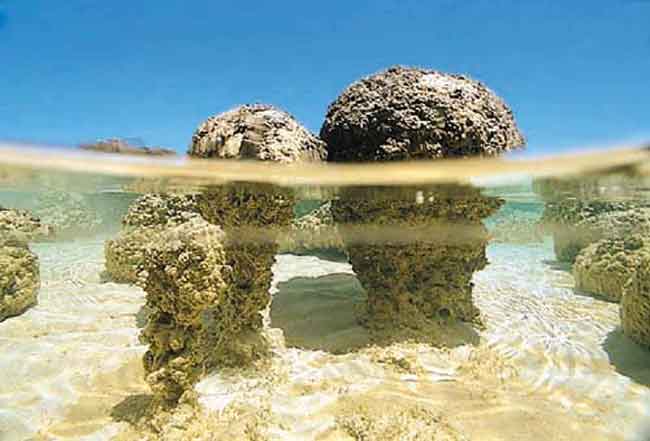Life's Origin May Have Been a Shallow Affair

In finding answers to the mystery of the origin of life, scientists may not have to dig too deep. New research is shedding light on shallower waters as a possible location for where life on Earth began.
Hydrothermal vents have been a focus of origin of life studies ever since the first one was discovered in 1977. These were mainly deep vents that averaged 2,100 meters [1.3 miles] down on the ocean floor. The hot gasses emanating from the center of the Earth through these vents could reach temperatures greater than 300 degrees Celsius.
These high temperatures caused some scientists to reject the possibility that life originated at deep sea hydrothermal vents, since organic molecules are unstable at such high temperatures.
In a paper published in the November issue of the journal Astrobiology, scientists point to shallow hydrothermal vents, at depths of 200 meters [656 feet] or less, as a possible location where the first signs of life emerged.
“Shallow water hydrothermal vents have been dismissed,” says lead author Marcelo Guzman, origins of life postdoctoral fellow at the School of Engineering and Applied Sciences and Department of Earth and Planetary Sciences at Harvard University. “There are plenty of shallow hydrothermal thermal vents but they have been studied less.”
The shallow depth makes it possible for the sun’s energy to reach the vents. Depths of 200 meters or less consist of the “photic zone,” regions of the ocean through which sunlight can penetrate, providing the required energy for chemical reactions. Sunlight is completely filtered out at depths beyond 200 meters. Temperature is also a factor.
“Shallow hydrothermal water systems are more temperate,” says Guzman.
Get the world’s most fascinating discoveries delivered straight to your inbox.
In shallow hydrothermal vents, temperatures range from 10 to 96 degrees Celsius, much milder than those of deep hydrothermal vents.
Shallow hydrothermal vents aren’t that common today, but they were probably more prevalent about four billion years ago when the Earth’s mantle had just cooled enough to form. There may have been less water on Earth at that time as well, since many scientists believe a majority of Earth’s water was delivered after formation, by asteroids and comets.
The earliest examples of ancient life are stromatolites – pillars of rock created by microbial mat colonies. Stromatolites are rare today, but usually form in shallow water. It would be a case of straight-forward evolution if the ancient stromatolites formed in the same environment where life itself was born.
Starting the Cycle
Scientists who study the origin of life tend to fall into one of two camps – geneticists or metabolists. Proponents of the "metabolism first" view believe that complex chemical reactions provided the environment from which a genetic system developed. The supporters of the "genetics first" theory argue that replicating polymers came first and made way for metabolism through evolution.
Though Guzman promotes the "metabolism first" perspective, he also believes there were "several mechanisms happening simultaneously, and the first original cell had both genetics and metabolism."
Assuming that is true, there are three requirements for a primitive metabolism: energy, a mineral catalyst and a perpetuating chemical cycle.
The energy for the shallow hydrothermal environment would have been provided by sunlight and the temperate heat of the vents. The mineral catalysts would have been part of the rocks that made up the vent structures. The perpetuating chemical reaction that Guzman and his colleague, Scot Martin, imagine to have existed on early Earth is the reverse Krebs cycle (also called the reductive tricarboxylic acid (rTCA) cycle or the reductive citric acid cycle), which uses carbon dioxide and water to make carbon compounds.
Even though the Krebs cycle is one of the most basic cycles life can use to “fix” carbon, Guzman says, it is still complex because specific enzymes work during each step. Guzman does not believe that enzymes existed before life originated, and therefore the Krebs cycle most likely evolved from something even more primitive.
“We're talking about prebiotic metabolism,” Guzman says. “Maybe metabolites in the environment allowed the first cells to have the chemistry they needed to run. Maybe in the first cell, a mineral catalyzed certain reactions.”
Guzman and Martin tried to chemically replicate the Krebs cycle – that is, without enzymes playing a role. They experimented with the semi-conducting mineral zinc sulfide as the catalyst. But iron, cadmium and manganese can also be used, says Guzman. Using a “colloidal suspension” (a chemical mixture in which a solid is suspended in a liquid) of zinc sulfide and sodium sulfide and exposing it to UV light, the research team was able to reproduce about 70 percent of the cycle.
“The inevitability of certain compounds appearing again and again kind of links to what people have been thinking about – the core metabolism as being the essential starting point,” says George Cody, senior research scientist at the Carnegie Institution of Washington.
Cody says he views this research study very favorably, and even though the finding is “not a quantum leap” in this area of research, “it’s an interesting bit of chemistry,” he says.
“It’s a set of experiments that other people aren’t doing,” Cody says. “It highlights how much work needs to be done. There are many different environments where one can simulate experiments, but there's a lot more to the story than just that. One has to link reliable chemistry with geochemical reality.”
In future research, Guzman hopes to be able to accurately simulate the chemical conditions of a hydrothermal vent in the lab.
Leslie Mullen contributed additional reporting for this article.
- The Greatest Mysteries in Science
- Oases for Life on the Mid-Caymen Rise
- Swashbuckling Scientists Discover Northern Vents


